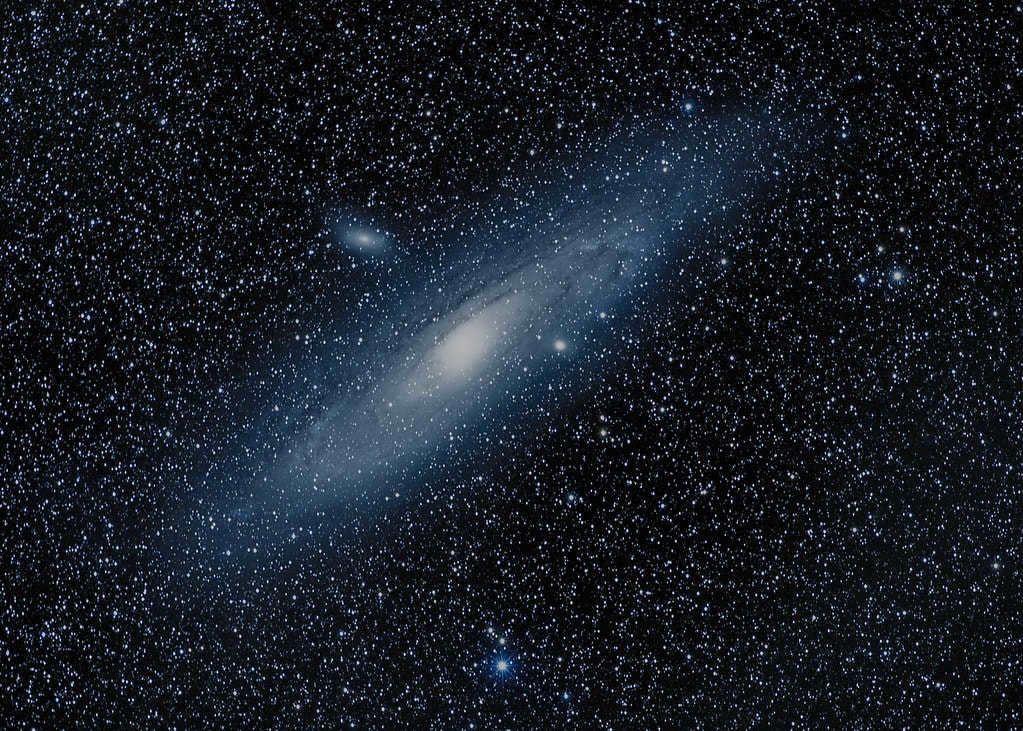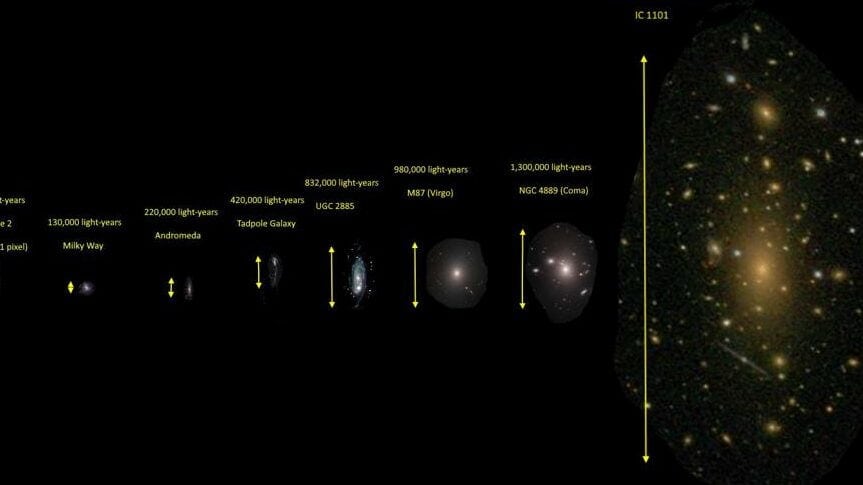There are various types of galaxies, including elliptical, lenticular, irregular, and radio galaxies. However, when it comes to size, which galaxy takes the crown as the largest in the universe?
What is the largest galaxy in the universe?
The size range in space is incredibly vast. From weightless photons to colossal black holes that consume matter and gather galaxies with trillions of stars, the universe is filled with awe-inspiring cosmic objects. But which galaxy can claim the prestigious title of being the largest in the universe? The answer to this seemingly simple question is not as straightforward as it may seem.
To grasp the concept of the biggest galaxy, we must initially comprehend the essence of galaxies as a whole. Typically, they are categorized based on their shape (such as elliptical, lenticular, irregular, spiral, etc.). Conventionally, galaxies are perceived as stellar clusters housing a central black hole, which are detectable through telescopic observation. In other words, they are visible within the optical range of radiation, accessible to the naked eye.
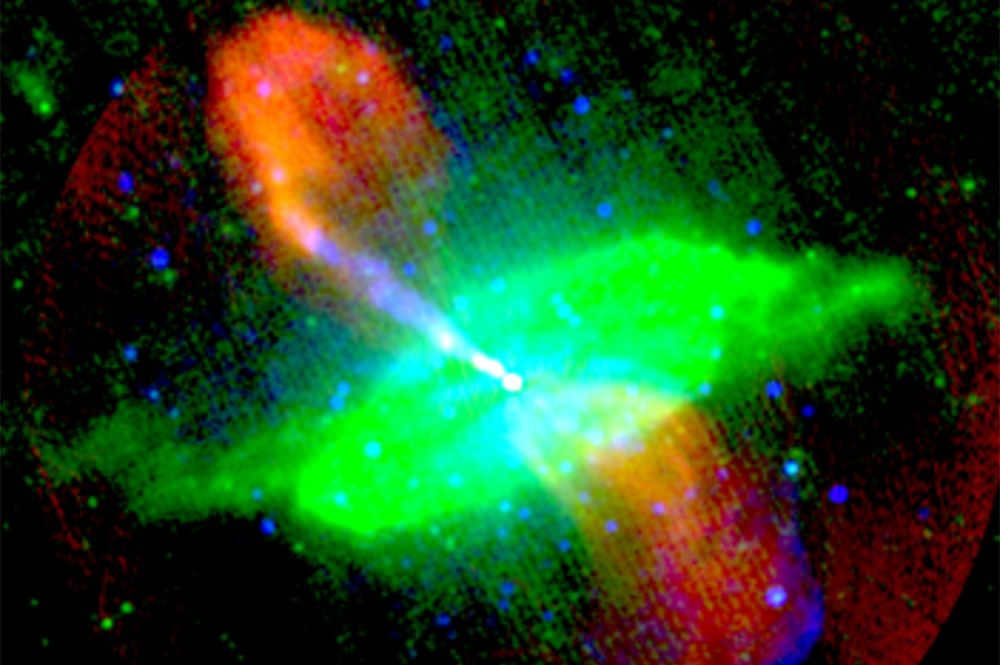
However, in the classification of galaxies, there exists a unique type – galaxies with active nuclei. These galaxies share a common characteristic: the processes occurring at their centers result in the release of an immense amount of energy. The magnitude of this energy, although imperceptible to the human eye, is often significantly larger than the observable size, as measured by instruments.
Among this category of galaxies, radio galaxies are considered the largest. These galaxies exhibit radio emissions that are greater than the average: ranging from 10 to 45 ergs per second (erg being a unit of energy). To put this into perspective, the radio emissions of the Milky Way, as well as other “normal” galaxies, are approximately 10 to the 38th degree ergs per second.
Radio galaxies are quite rare. They are able to produce such powerful radiation due to the extremely intense absorption of matter by the supermassive black hole located at their core. This absorption process results in the creation of high-energy jet streams, with two jets moving in opposite directions, near the black hole. These jet streams allow particles to accelerate to speeds that are close to that of light. It is these jet streams that are particularly well-detected in the radio frequency range.
When we consider not only the apparent size of the galaxy, but also the entire “radio cocoon” surrounding it, we find that these galaxies are of colossal proportions. In fact, they currently hold the record for being the largest galaxies known to us.
To this day, approximately 1000 colossal radio galaxies have been uncovered, although only 10 of them exceed a span of 10 million light years. Furthermore, thanks to the continuous advancements in ground-based telescopes, astronomers have recently been uncovering an increasing number of these “largest” galaxies.
By and large, astronomy employs a variety of techniques to ascertain the magnitude of galaxies, and each approach can yield distinct outcomes.
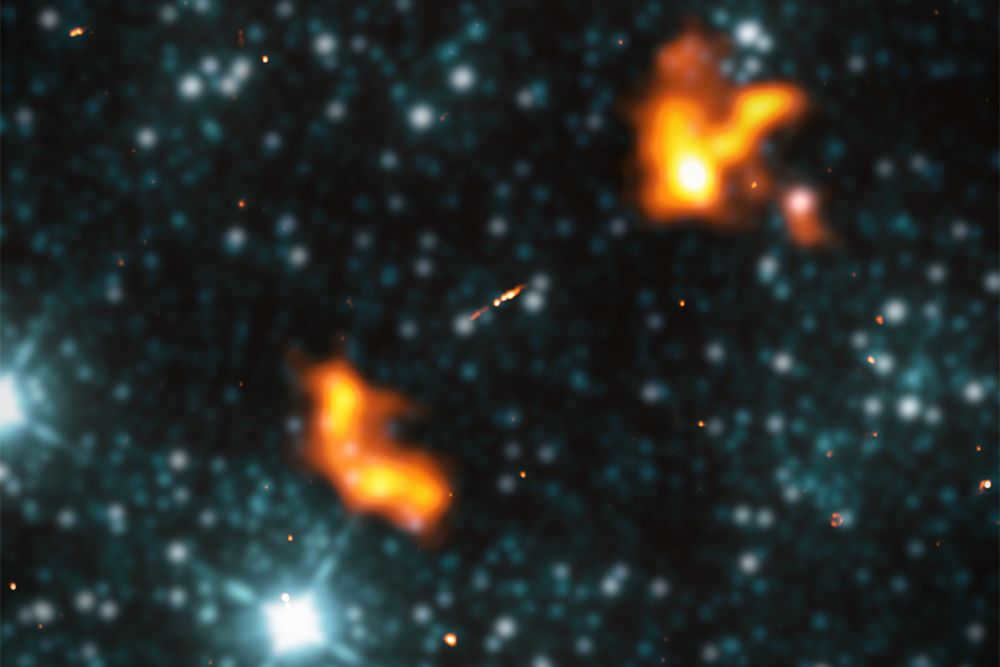
J1420-0545. Previous title holder
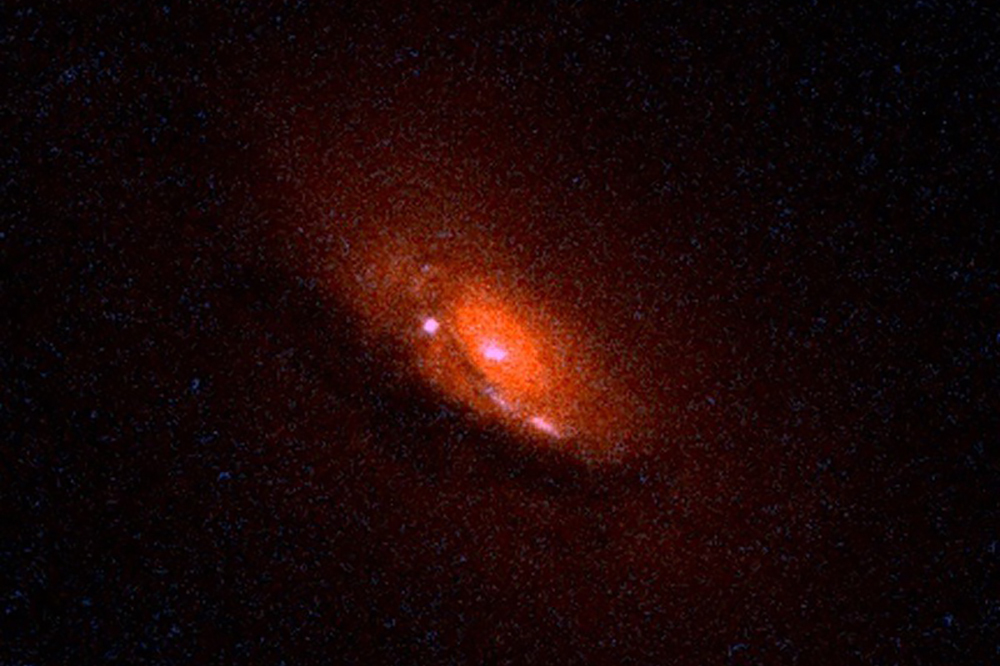
Until 2022, the largest known radio galaxy was believed to be J1420-0545. With a size of 16 million light years, it is located on the border between the constellations of Draco and Ursa Minor, approximately 2.3 billion light years away. Interestingly, this galaxy was initially only detected in the radio range, with no optical light observed. It was not until 2015 that successful optical photometry was conducted, revealing that J1420-0545 is also an elliptical galaxy.
IC 1101. The biggest galaxy that can be seen with the naked eye.
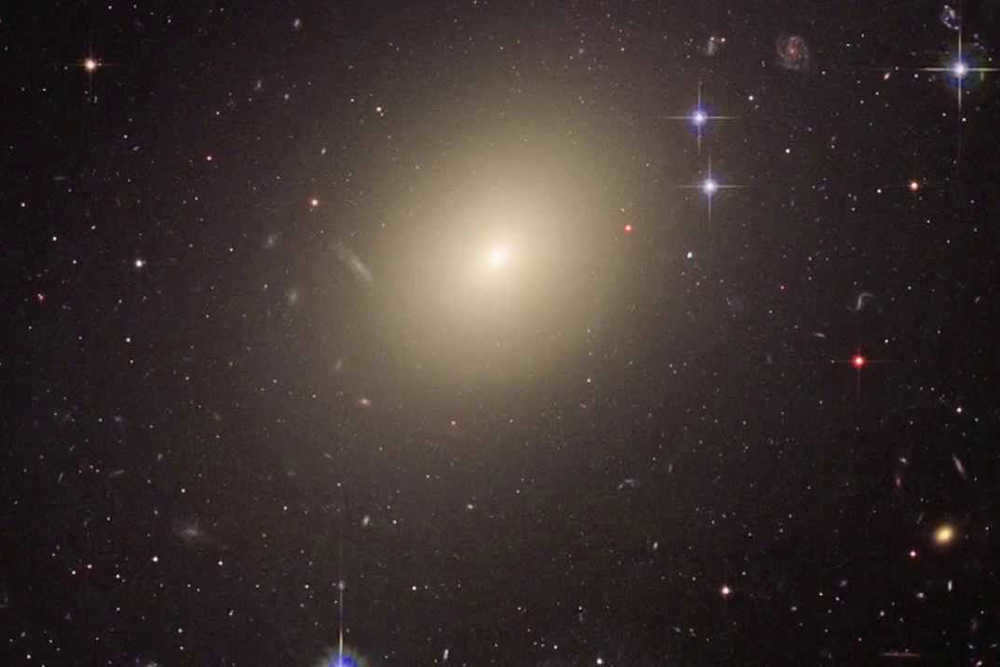
The biggest galaxy that can be seen through a telescope by the naked eye. Its size in the visible light spectrum is approximately 6 million light years. Situated 1.04 billion light-years away from Earth, in the Virgo constellation.
This galaxy serves as the central point of the vast Abell 2029 cluster. IC 1101 is 60 times larger than the Milky Way and 20 times more massive. It occupies such a vast space that if it were to replace our galaxy, not only would the Milky Way be engulfed, but also the neighboring Large and Small Magellanic Clouds, the Andromeda Nebula, and the Triangulum Galaxy.
Discovered by the renowned English astronomer William Herschel in 1790, ESO 383-76 is highly visible in the optical range.
Notably Elongated ESO 383-76
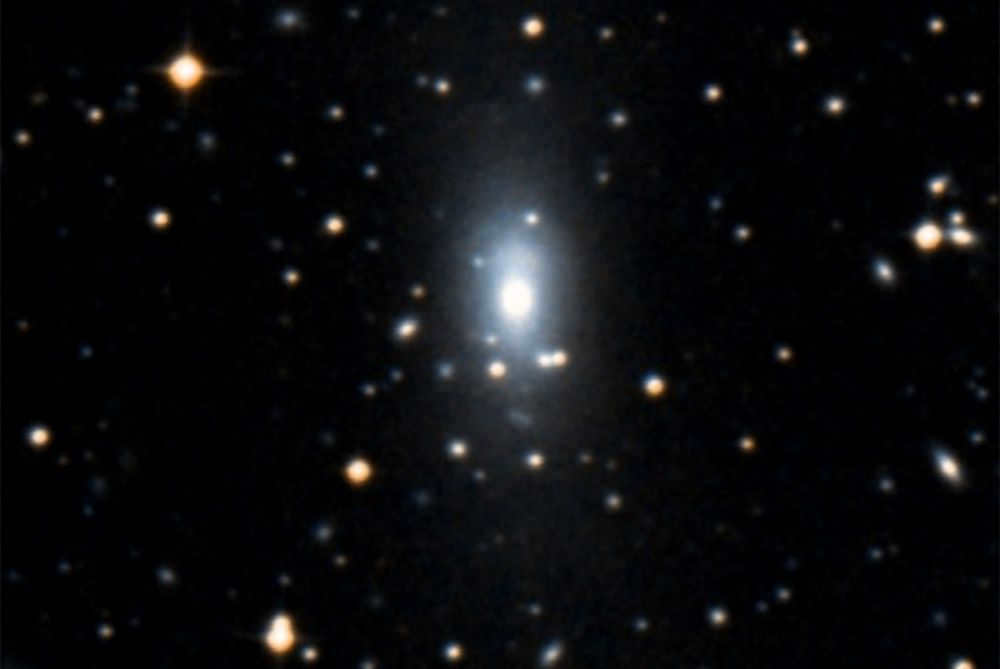
Situated in the constellation Centaurus, the Abell 3571 cluster boasts the most brilliant supergiant elliptical galaxy known as an elongated, X-ray luminous galaxy. This particular galaxy stands out not only for its luminosity, but also for its size, as it is one of the largest galaxies in the nearby universe. With a diameter measuring approximately 1.76 million light-years, it is remarkable for its elongated shape, where its length is twice its width.
Hercules A, also known as 3C 348, exhibits pulsations across the universe
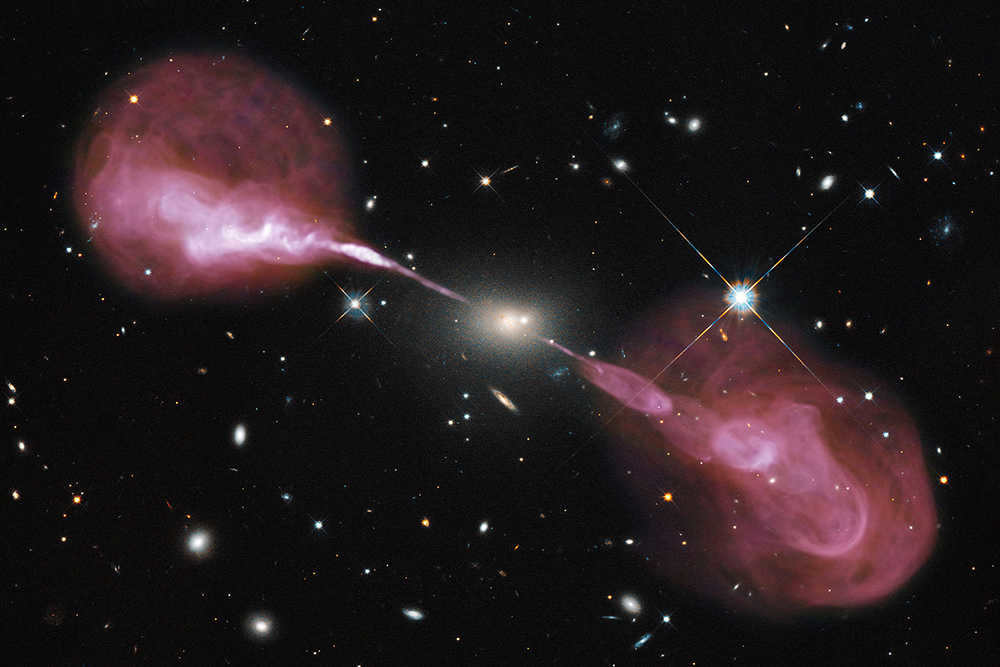
Although it may not appear particularly extraordinary in the optical range, this massive radio galaxy is actually one of the most impressive sources of radio waves in the entire universe. The incredible power of this galactic phenomenon can be attributed to a black hole with a mass exceeding 4 billion times that of our sun. This colossal black hole emits radio jets that span a staggering 1.5 million light-years in total length. What sets Hercules A apart is the unique structure of its radio clouds, which exhibit distinct “layers” and pulsate rather than continuously flow. These distinctive characteristics make Hercules A an object of great interest and significance.
Located 2.1 billion light-years away from Earth in the constellation Hercules, this elliptical galaxy is appropriately named Hercules A.
NGC 262, also known as Markarian 348. A massive spiral galaxy.
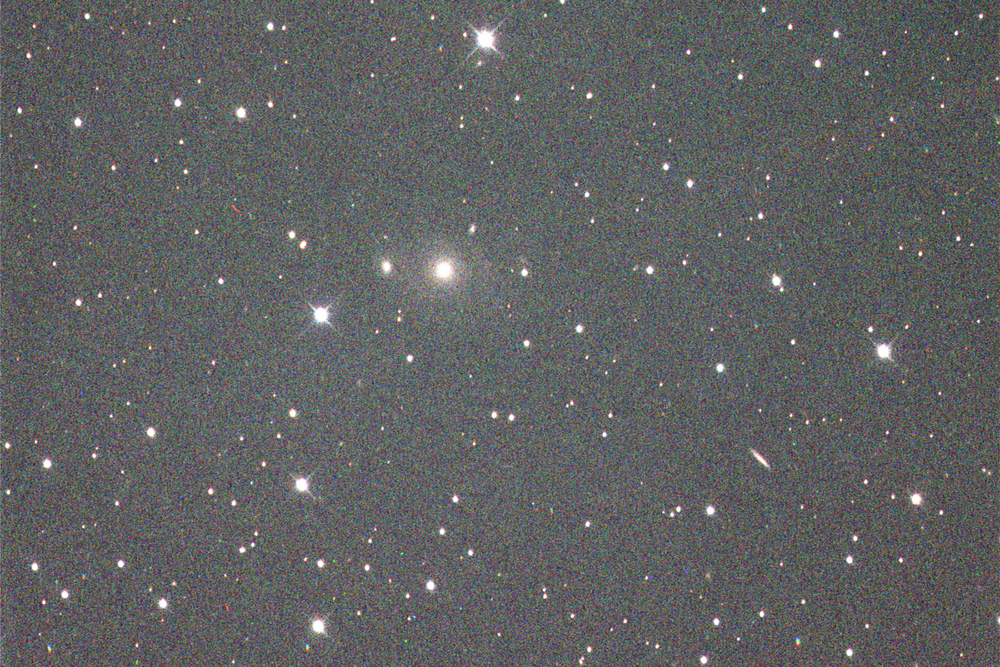
The initial spiral galaxy situated at the summit of the most extensive galaxies. This faint entity positioned in the Andromeda constellation, 2 billion light-years away from Earth. It possesses a unique characteristic of appearing nearly parallel to our planet. Its breadth exceeds 1 million light-years.
NGC 262 is exceedingly uncommon since it is approximately 10 times the magnitude of a typical spiral galaxy. The presence of an immense cloud of neutral hydrogen enveloping it is a notable feature, most likely resulting from gravitational interaction with the accompanying galaxy NGC 266.
Abell 2261-BCG. Misplaced its black hole
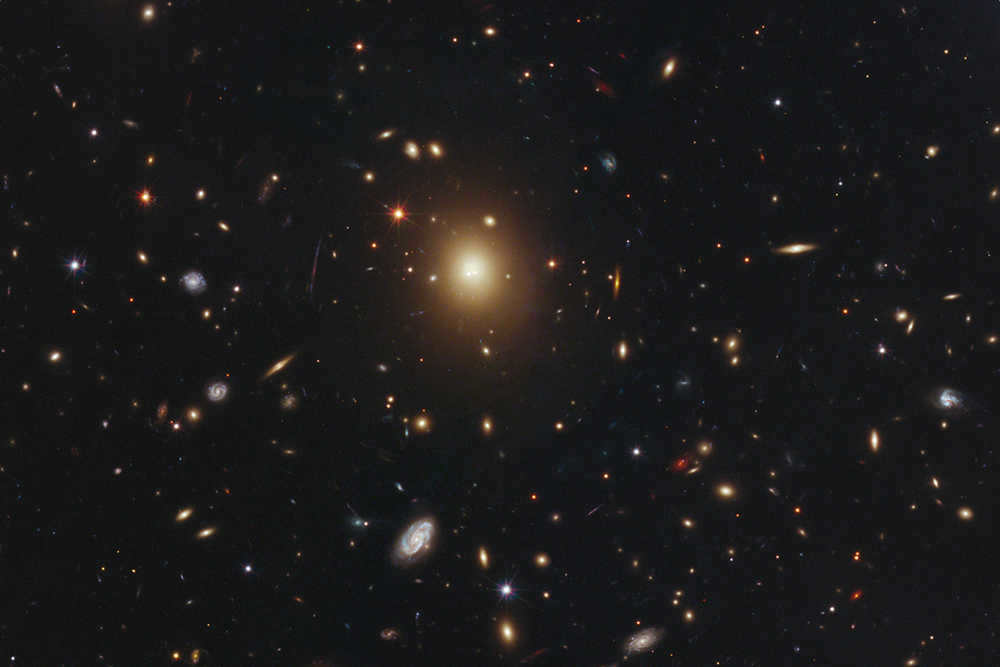
One of the most peculiar galaxies in the observable Universe. It is considered one of the largest, with a size exceeding 1 million light-years. This particular elliptical galaxy holds the record for being the largest member of the Abell 2261 cluster and is situated in the constellation of Hercules, approximately 3 billion light-years away from our planet.
Nevertheless, what sets it apart is the absence of a black hole at its core, which is quite remarkable. Typically, the center of a galaxy is more luminous and active, but in this case, the brightness level is similar to other regions. Additionally, the nucleus of Abell 2261-BCG is unusually large, measuring three times the size of other galaxies of its kind.
ESO 306-17. Devoured every other galaxy
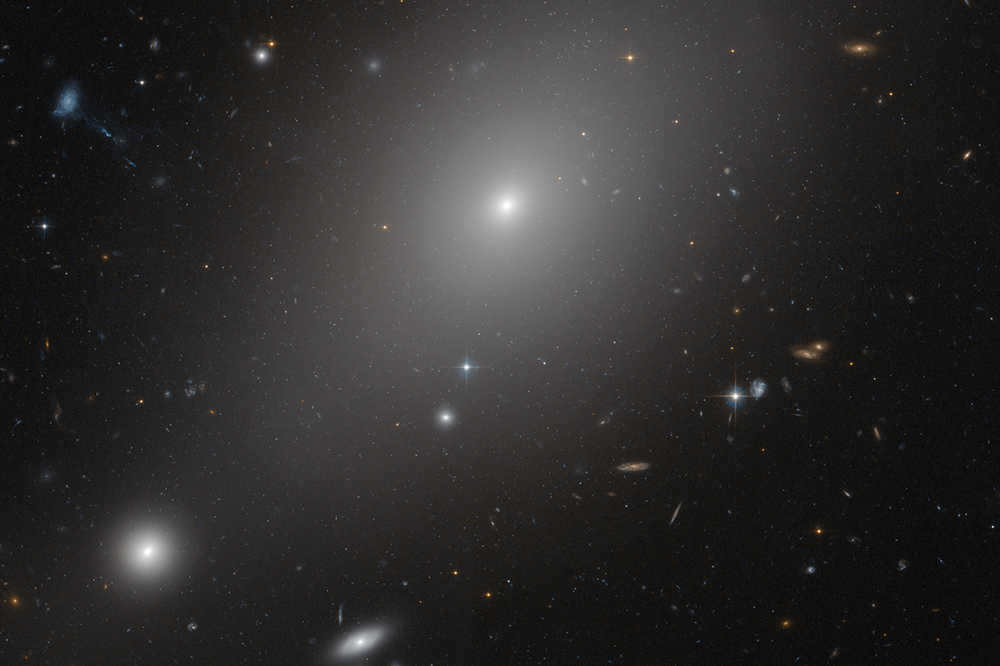
There is another gigantic elliptical galaxy that spans a diameter of 1 million light-years. It can be found 500 million light-years away in the constellation Columbus. What makes it intriguing is that, within its own region of space, there are no other galaxies. This is quite peculiar as galaxies tend to be arranged in clusters. It is highly likely that this colossal entity simply attracted and absorbed all the surrounding galaxies, leaving it isolated. These types of objects, like ESO 306-17, are commonly referred to as “fossil” galaxies.
The content on this website may include materials sourced from various online platforms such as Facebook and Instagram, which are owned by Meta Platforms Inc. Unfortunately, access to these platforms is restricted in the Russian Federation.
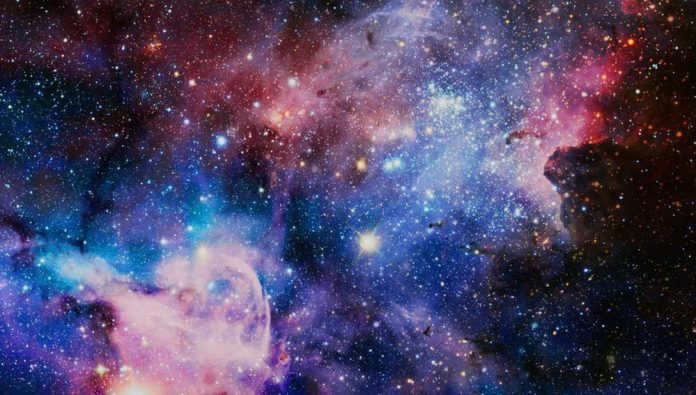
The cosmos is an expansive and enigmatic realm, brimming with enigmas that we are just beginning to fathom. From the tiniest subatomic particles to the grandest structures in existence, it teems with extraordinary phenomena that inspire awe and curiosity. Among the most astounding entities in the cosmos are galaxies, which come in a variety of shapes and sizes, each possessing its own unique characteristics.
Thus far, over 100 billion galaxies have been identified in the observable portion of the cosmos, but this number continues to expand as technology and space exploration methods advance. In fact, some scientists propose that the actual number of galaxies could surpass two trillion.
10. NGC 224 (Andromeda Galaxy)
The Andromeda Galaxy, also known as NGC 224, is a spiral galaxy located approximately 2.537 million light-years away from Earth. It is the nearest major galaxy to the Milky Way and is an important object of study for astronomers. The Andromeda Galaxy is visible to the naked eye in the night sky and has been observed and studied for centuries. It has a diameter of about 220,000 light-years and is estimated to contain over a trillion stars. The galaxy is known for its beautiful spiral structure and is often compared to our own Milky Way. Scientists believe that the Andromeda Galaxy and the Milky Way will eventually collide and merge in about 4 billion years, creating a new, larger galaxy. This event is expected to reshape both galaxies and have a significant impact on the structure and evolution of the local group of galaxies.
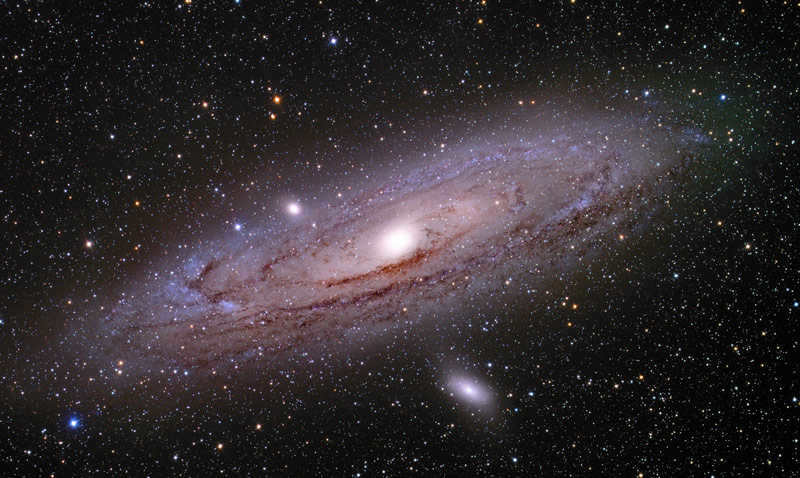
Dimensions: 220,000 light-years
Year of detection: 964 A.D.
Distance from Earth: 2.537 million light years
Constellation: Andromeda
NGC 224, also referred to as the Andromeda Galaxy, is a vast spiral galaxy situated roughly 2.5 million light-years away from Earth in the Andromeda constellation. NGC 224 is the closest neighboring galaxy to our own Milky Way and has been the subject of extensive research in the night sky.
Scientists have determined that the Andromeda Galaxy is moving closer to the Milky Way at a rate of approximately 110 kilometers per second. In about 4.5 billion years, the two galaxies will collide and merge to form a new, larger entity.
NGC 224 is easily observable without any optical aids and has been recognized since ancient times. The initial reference to it as a celestial body was documented in the records of Al-Sufi, an astronomer, in 964. Nevertheless, the primary organized scientific publication about NGC 224 was released in 1612 by Simon Marius, a German astronomer, who was the first to observe it using a telescope and bestowed upon it the name Andromeda, in tribute to the legendary Greek heroine.
9. UGC 10214 (Tadpole Galaxy)
The Tadpole Galaxy, also known as UGC 10214, is a well-studied spiral galaxy located approximately 420 million light-years away from Earth. It is named after its distinctive shape, which resembles that of a tadpole. The galaxy was first discovered by astronomers in 2004 and has since been the subject of numerous studies and observations.
One of the most notable features of the Tadpole Galaxy is its long, extended tail, which stretches for more than 280,000 light-years. This tail is thought to have been formed through a process known as tidal stripping, in which gravitational interactions with other galaxies cause the outer layers of gas and stars to be pulled away. The tail is composed of young, blue stars, indicating ongoing star formation within the galaxy.
In addition to its unique shape, the Tadpole Galaxy also exhibits other interesting characteristics. It has a high rate of star formation, with new stars being born at a rate of approximately four times that of our own Milky Way galaxy. The galaxy also has a relatively high metallicity, which means it contains a higher abundance of heavy elements such as carbon and oxygen.
The Tadpole Galaxy has been extensively studied using various astronomical instruments, including the Hubble Space Telescope. These observations have provided valuable insights into the processes of galaxy formation and evolution. The galaxy’s unique features make it a fascinating object of study for astronomers, and it continues to be a subject of ongoing research.
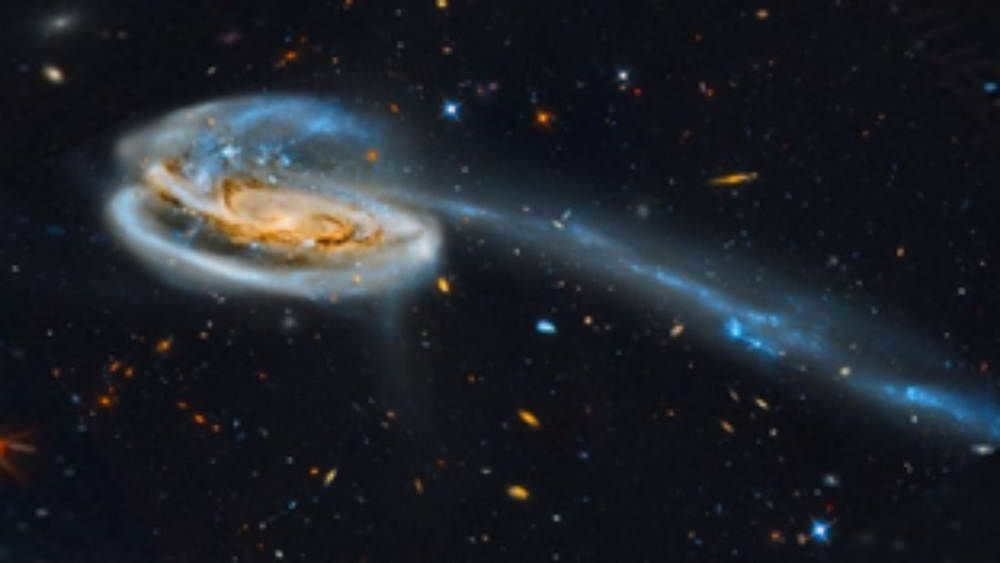
Dimensions: 280,000 light-years
Year of detection: 2001
Distance from our planet: 420 million light years
Constellation: Dragon
The Tadpole Galaxy, also referred to as UGC 10214 or ARP 188, can be found approximately 420 million light-years away from Earth in the Dragon constellation. It was identified by the Hubble Telescope in 2001 and earned its name due to its distinctive resemblance to a tadpole.
UGC 10214 possesses a luminous, elongated core and an extensive, curved appendage spanning over 280,000 light-years in length. Comprised of gas, dust, and celestial bodies that have been forcibly separated from the smaller accompanying galaxy due to the gravitational pull of the larger galaxy, this appendage is referred to as a galactic cannibalism event. Such phenomena are quite prevalent in our vast Universe.
What sets UGC 10214 apart is its remarkable capacity for generating new stars. In fact, it stands as one of the most vibrant star-forming galaxies currently known to humanity. The rate at which new stars are being born within it is ten times greater than that of our own Milky Way.
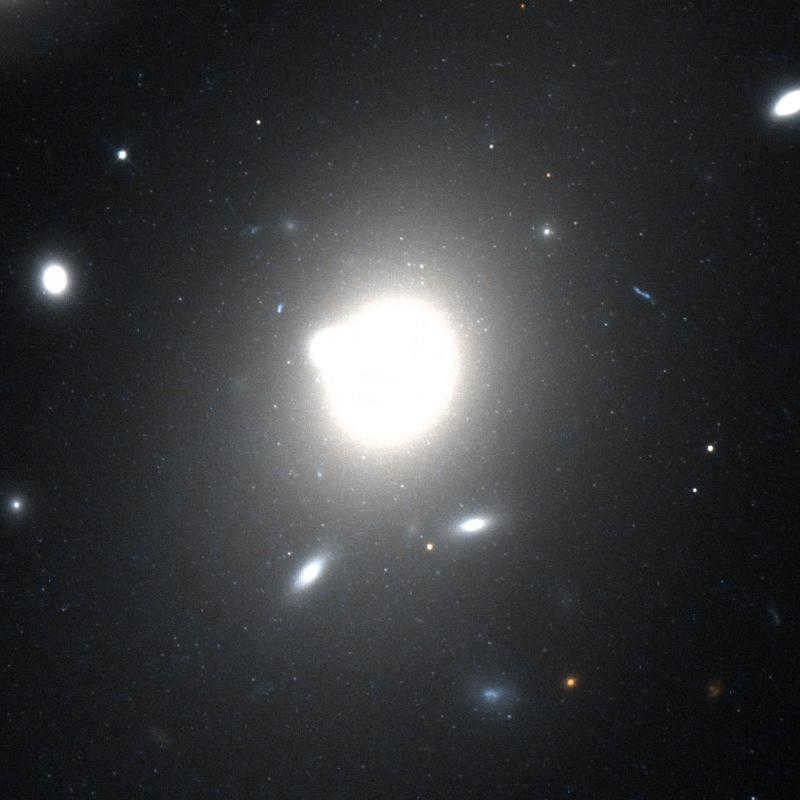
Dimensions: 402,000 light-years
Year of initial detection: 1834
Distance from our planet: 640 million light years
Star grouping: Centaurus
ESO 444-46 represents a spiral-shaped galaxy situated in the Centaurus constellation. It is an essential constituent of the ESO 444 galaxy group and is formally recorded in the astronomical directory as ESO 444-46.
Observations indicate that ESO 444-46 encompasses a relatively substantial quantity of gas, thereby fostering the conditions for ongoing star generation. Within this galaxy, there is also a supermassive black hole that holds particular interest to the scientific community.
ESO 444-46 is currently acknowledged as the most extensive concentration of matter within the observable Universe. It possesses an equivalent magnitude to that of 10,000 galaxies akin to the Milky Way and encompasses 27,000 globular star clusters.
7. NGC 6872 (Condor Galaxy).
The Condor Galaxy, also known as NGC 6872, is a spiral galaxy located in the constellation of Pavo. It is one of the largest galaxies known, with an estimated diameter of about 522,000 light-years. The galaxy is famous for its long, curved arms that give it a shape reminiscent of a bird in flight, which is why it is called the Condor Galaxy. NGC 6872 is also a member of a small galaxy group called the Pavo Group, which consists of several other galaxies. The galaxy is approximately 212 million light-years away from Earth, making it relatively close by cosmic standards.
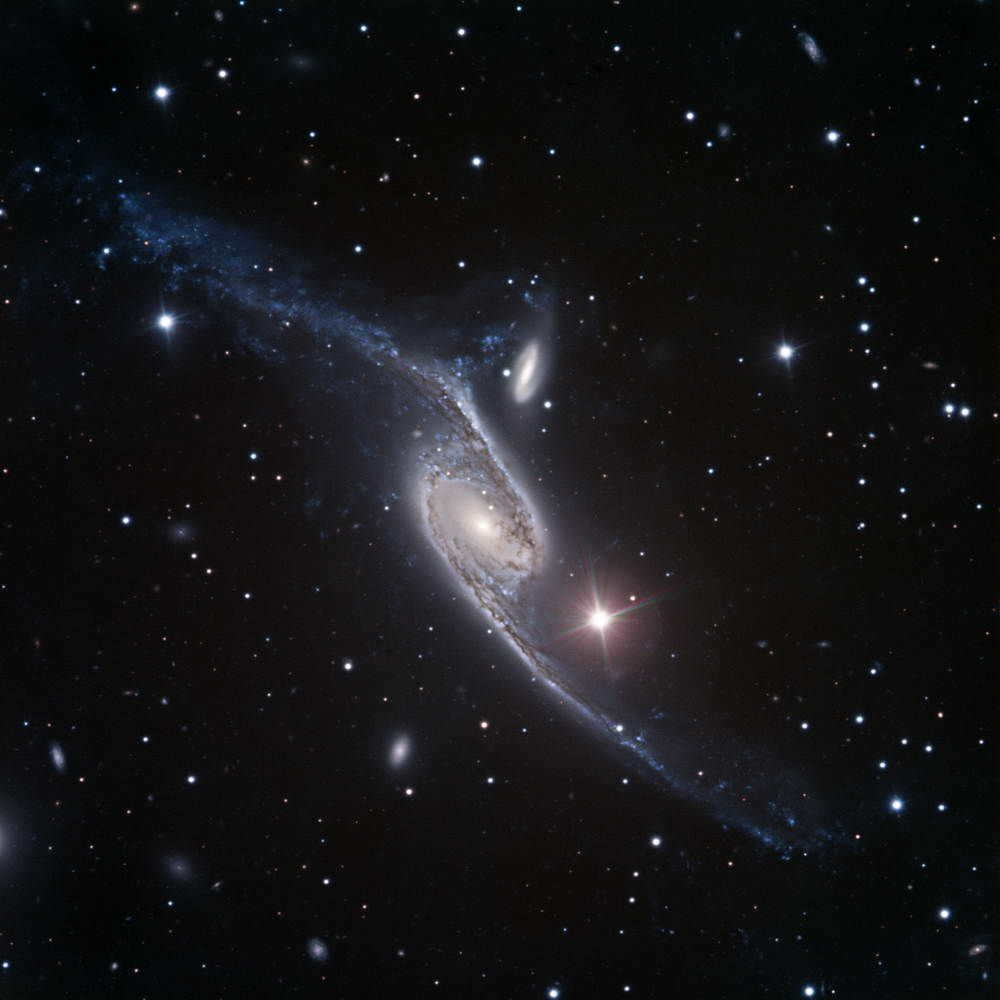
Dimensions: The size of NGC 6872 is an astounding 522,000 light-years.
Discovery: NGC 6872 was first observed and documented in 1835.
Distance from Earth: The galaxy is located approximately 212 million light-years away from our planet.
Location: NGC 6872 can be found in the constellation Peacock.
The Condor Galaxy, also known as NGC 6872, is recognized as one of the largest spiral galaxies in existence. It was initially identified by the renowned British astronomer John Hersh on June 27, 1985.
This remarkable galaxy, the Condor, stands out due to its extensive spiral arms that stretch across a significant distance, resembling a pair of wings. At its widest point, NGC 6872 spans an incredible 522 thousand light-years, making it five times larger than our very own Milky Way.
NGC 6872 has an intriguing characteristic in its interaction with another galaxy, IC 4970, which is positioned on its outer perimeter. The gravitational force between these two galaxies has caused a distortion in their shapes and resulted in the formation of elongated tails where active star production is occurring.
6. Galaxy resembling a comet
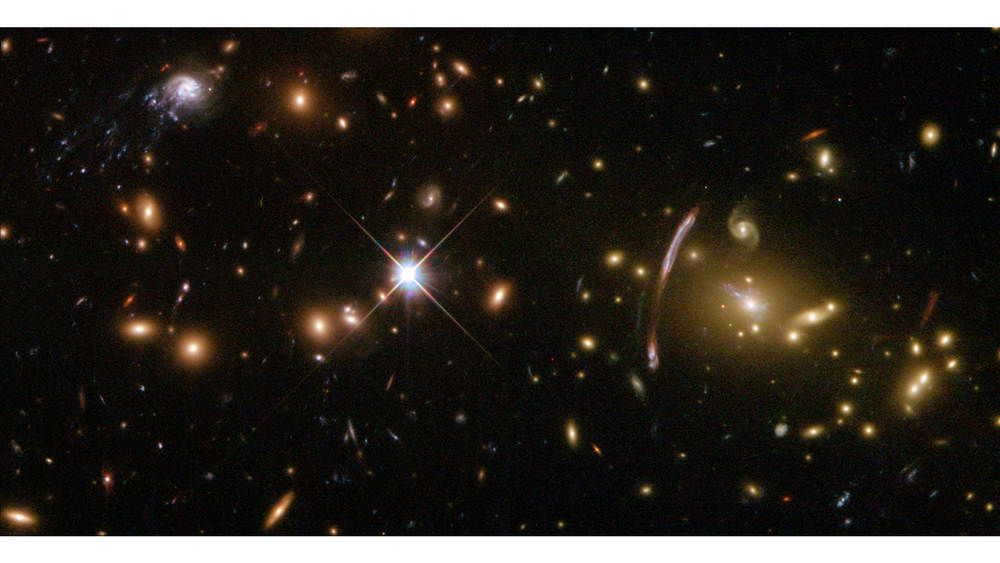
Size: 600,000 light-years
Year of discovery: 2007
Distance from Earth: 3.2 billion light years
Constellation: Sculptor
The Comet Galaxy can be found within the vibrant Abell 2667 cluster in the X-ray spectrum, situated an astonishing distance of over three billion light-years away from our own solar system. It was only recently identified in 2007, with credit going to the remarkable Hubble telescope.
Presently, the Comet Galaxy is traversing a cluster of neighboring galaxies that are actively tearing it apart, propelling it at an astonishing speed of over three million kilometers per hour. Due to external gravitational forces, it will eventually shed its gas, resulting in the termination of star formation and a gradual contraction.
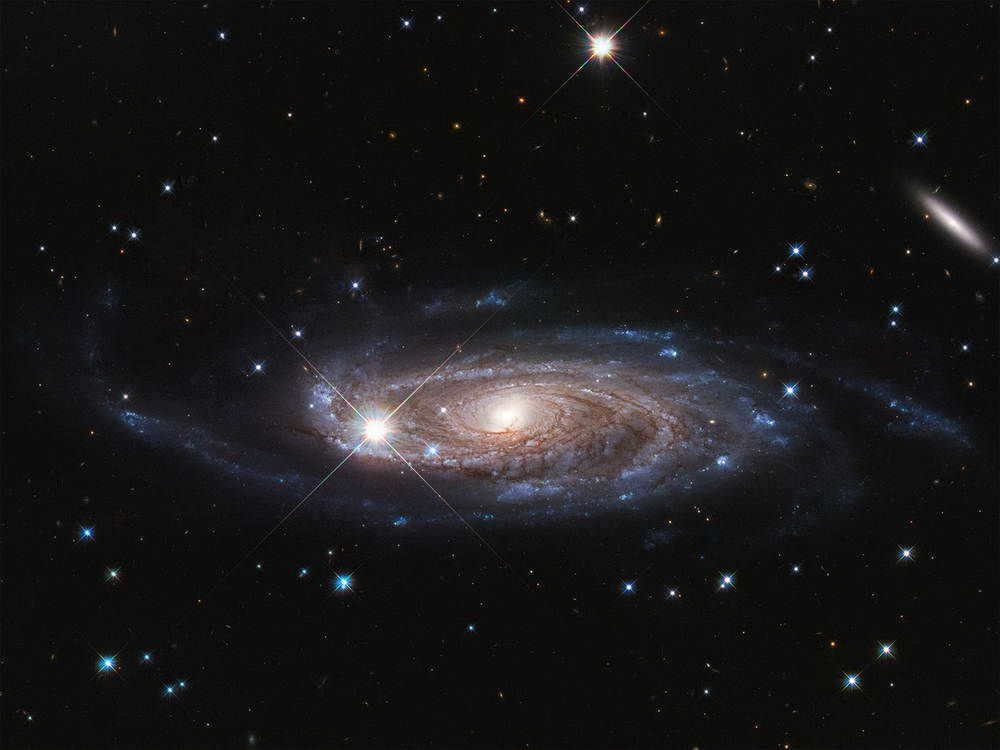
Dimensions: 832,000 light-years
Year of discovery: 2002
Distance from Earth: 313 million light years
Constellation: Perseus
UGC 2885 is a massive spiral galaxy without a central junction located in the Perseus constellation. It is renowned as the largest spiral galaxy in the entire observable Universe. UGC 2885 has a diameter measuring 830 thousand light-years and contains billions of stars. However, the majority of these stars are concentrated toward the galaxy’s core, giving it a rather distinctive characteristic.
The unique structure of UGC 2885 has sparked numerous theories regarding its formation. The prevailing belief suggests that it originated solely from gas, as opposed to being the result of smaller galaxies merging together.
4. ESO 306-17
ESO 306-17 is a unique astronomical object that has captured the attention of scientists and researchers. This fascinating celestial body presents a myriad of questions and possibilities. Its unusual characteristics and behavior have perplexed experts in the field and sparked numerous investigations.
ESO 306-17 offers a glimpse into the mysteries of the universe, providing valuable insights into the nature of galaxies and the processes that shape them. Its distinct features set it apart from other known objects, making it a fascinating subject for study and analysis.
Scientists have been studying ESO 306-17 for years, attempting to unravel its secrets and understand its origins. The data collected from these observations has led to groundbreaking discoveries and advancements in our understanding of the cosmos.
ESO 306-17 serves as a reminder of the vastness and complexity of the universe, challenging our preconceived notions and pushing the boundaries of our knowledge. As scientists continue to study and explore this enigmatic object, new revelations are sure to emerge, further expanding our understanding of the cosmos.
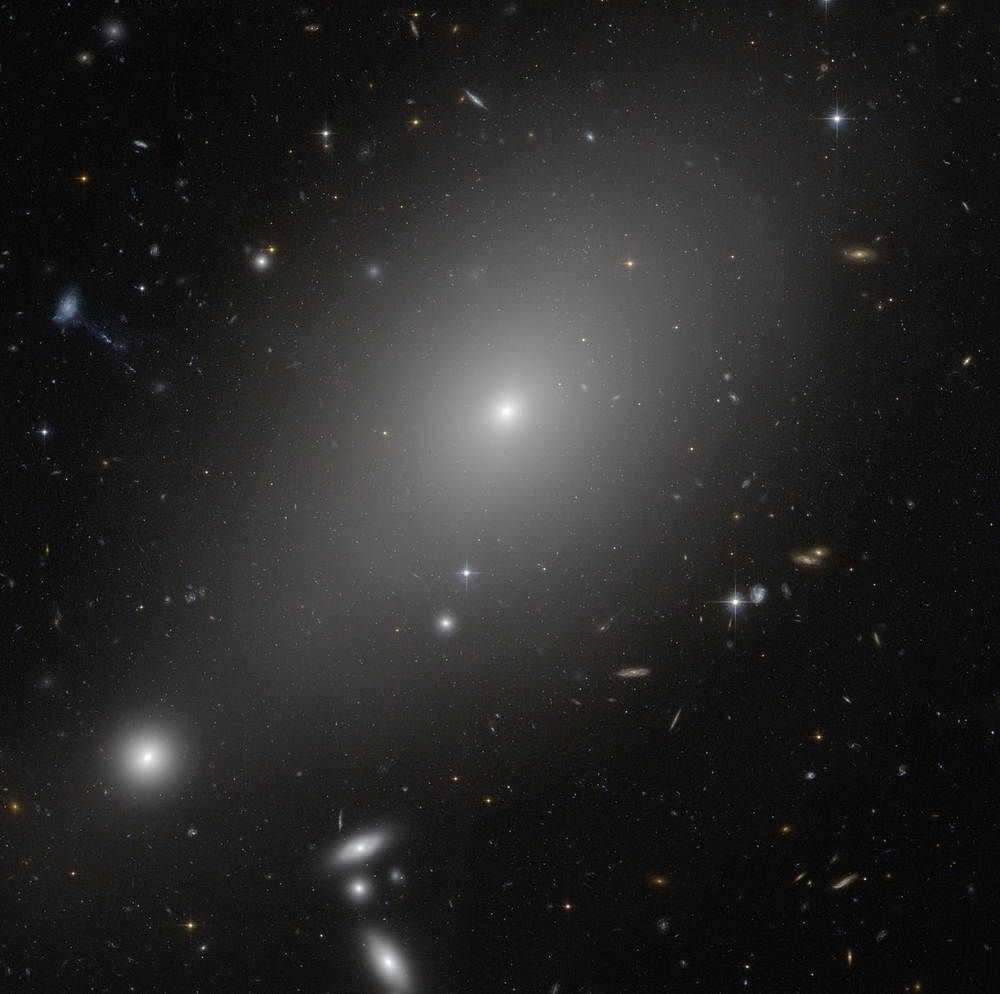
Size: 1,000,000 light-years
Year of discovery: 2005
Distance from Earth: 500 million light years
Constellation: Dove
The galaxy known as ESO 306-17 can be found in the Dove constellation and is classified as a massive elliptical galaxy with a unique form. It has a diameter of approximately 1 million light-years and is positioned about 500 million light-years away from our planet. As a result, we are currently observing it as it existed during the time of the Cambrian Explosion, a period marked by the emergence of numerous original life forms on Earth.
ESO 306-17 stands out in the vastness of space, capturing the attention of astronomers. What makes this galaxy even more intriguing is its ability to consume its neighboring galaxies, defying the skeptics who doubted such a phenomenon.
3. A2261-BCG
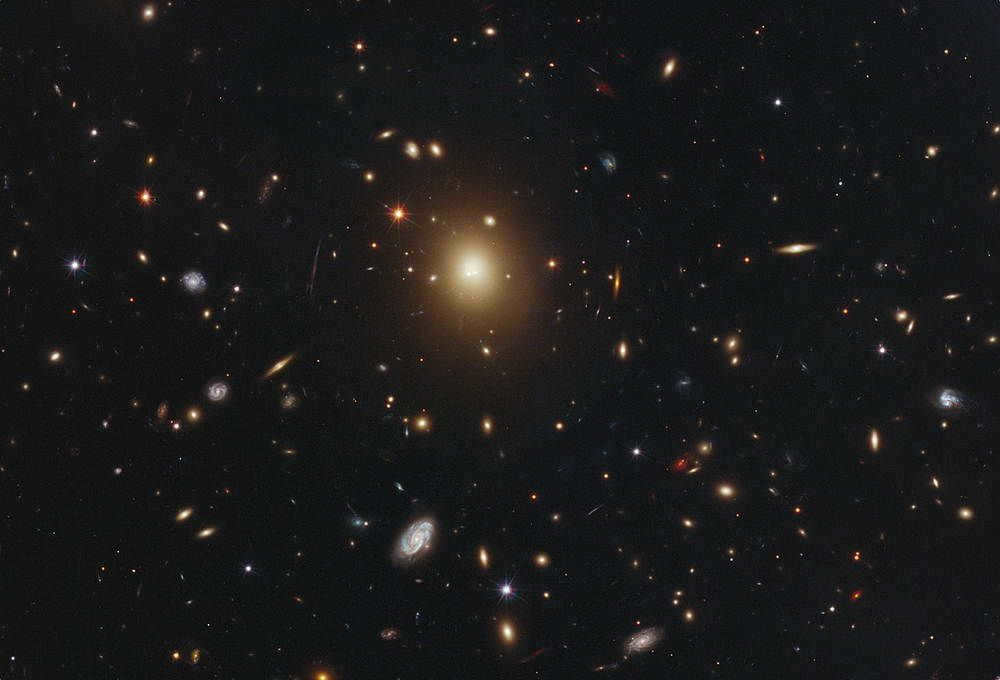
Dimensions: 1,000,000 light-years
Year of finding: 2012
Distance from our planet: 2.7 billion light years
Star group: Hercules
A2261-BCG is the leading elliptical galaxy in the Abell 2261 cluster. It is the most luminous and massive galaxy in the cluster and possesses one of the largest galactic cores ever observed, stretching over 10,000 light-years.
However, quite remarkably, no supermassive black hole has yet been detected at the nucleus of A2261-BCG, even though it should certainly exist in such a colossal galaxy. Scientists theorize that it may have been expelled beyond Abell 2261, or its activity is currently so insignificant that modern instruments cannot detect it.
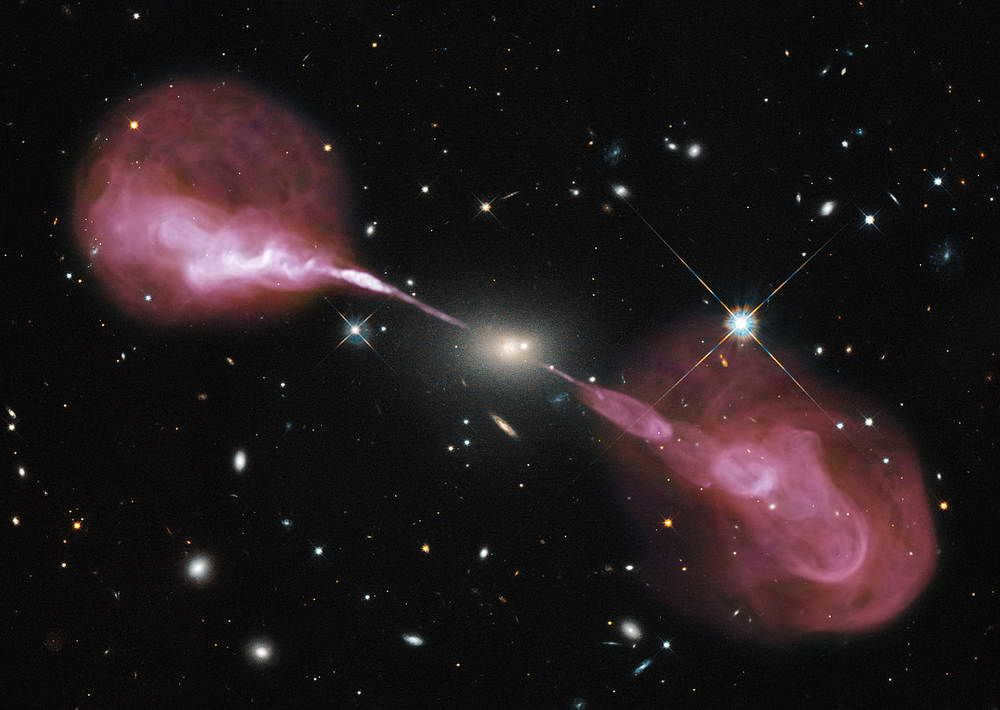
Size: 1,500,000 light-years
Year of discovery: 1959
Distance from Earth: 2.1 billion light-years
Constellation: Hercules
Hercules A was first observed in 1959 and is situated approximately 2.1 billion light-years away from Earth. It is an immense elliptical galaxy, falling under the category of radio galaxies, which are characterized by their strong radio emissions emanating from their central regions. Additionally, Hercules A is classified as a cD galaxy, which refers to the largest and most massive galaxies found in clusters.
The focal point of Hercules A is its supermassive black hole, which is estimated to be 2.5 billion times the mass of the Sun. This black hole is responsible for the galaxy’s powerful radio emissions, making it a prominent feature of Hercules A.
1. IC 1101
IC 1101 is a supergiant elliptical galaxy located in the constellation of Serpens. It is one of the largest known galaxies in the observable universe. IC 1101 has a mass of about 100 trillion stars and is estimated to be around 6 million light-years in diameter. This massive galaxy is believed to have formed through the merger of multiple smaller galaxies over billions of years. Its size and mass make IC 1101 a fascinating object of study for astronomers, who hope to gain insights into the formation and evolution of galaxies.
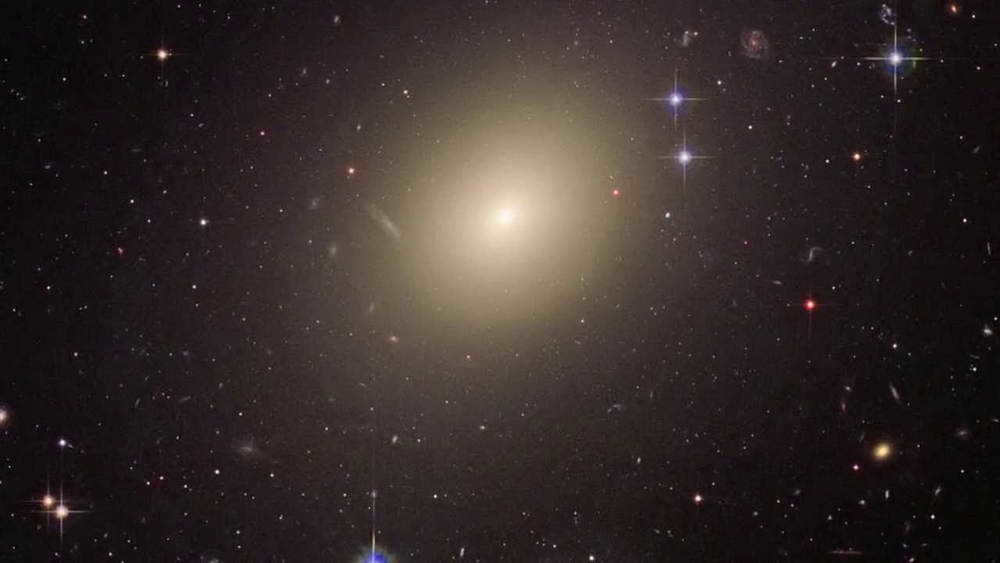
Dimensions: 4,000,000 light-years
Year of detection: 1790
Distance from Earth: 1.04 billion light years
Constellation: Virgo
IC 1101 stands out as the most colossal galaxy within the observable universe. It was first observed in 1790 by the British astronomer William Herschel. This gigantic elliptical galaxy boasts an astonishing amount of over 100 trillion stars, vast quantities of dark matter, and it is a whopping 50 times larger than our very own Milky Way galaxy!
Unlike spiral galaxies like the Milky Way, IC 1101 lacks the distinctive spiral arms. Instead, it exhibits a smooth and uniform structure, characterized by a dense concentration of stars at its core.
The center of IC 1101 is also the residence of the largest black hole that humanity is aware of. Its mass is approximately 40 billion times that of the Sun. The existence of such an immense black hole suggests that IC 1101 has undergone significant activity at its galactic core in previous times.
There are countless galaxies scattered throughout the vast expanse of the Universe. And within this cosmic tapestry lie a multitude of peculiar entities. A jellyfish galaxy, a devourer, a leech, an undead. We bring to you a compilation of the most remarkable ones.
Explore “Hitech” Magazine
The cosmos contains an unimaginable number of galaxies, and the exact count remains a mystery. The observable Universe, known as the Metagalaxy, continues to expand as advancements in astronomical technology allow for further exploration.
Among these galaxies, one stands out as the largest in terms of width – IC 1101. With a diameter of approximately 6 million light years, this colossal structure dominates the cosmic landscape. Another noteworthy neighbor is the Andromeda galaxy, located a mere 2.5 million light-years away from Earth in the constellation of the same name. Of course, our own home, the Milky Way, also resides within the galactic ensemble. However, the wonders of space extend far beyond these familiar names, and there are countless captivating objects awaiting discovery.
Located in the constellation Triangulum Australe, the galaxy ESO 137-001 bears a striking resemblance to a floating jellyfish amidst a vast expanse of stars. This spiral galaxy features a central rod-like structure, around which its stars form a spiral shape. Additionally, ESO 137-001 boasts tendrils of stars that gracefully drift, reminiscent of the tentacles of a jellyfish.
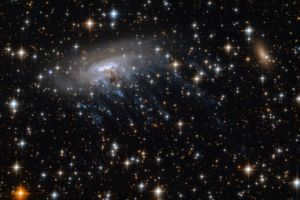
As per the information provided by NASA, the formation of these stars occurs within a trail of dust and gas (which cannot be seen with the naked eye) that is emitted from ESO 137-001. The reason behind this phenomenon remains a mystery; scientific principles indicate that the gases in the trail might have a temperature that is too high for the formation of stars.
Zombie galaxy
The enormous galaxy MACS 2129-1, shaped like a disk, is rotating at double the speed of our own Milky Way. However, despite its rapid motion, it lacks the vibrant activity commonly found in galaxies. According to data gathered by the Hubble Space Telescope, this galaxy has remained starless for a staggering 10 billion years, earning it the eerie nickname of “dead.”
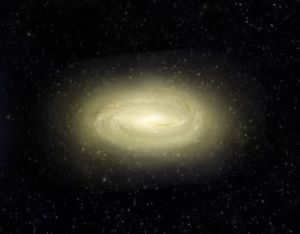
The findings, which were published in the Nature journal in 2017, indicate that aging galaxies like MACS 2129-1 undergo some kind of internal restructuring rather than changing their shape through mergers with other galaxies.
A Galaxy That Feasts
A study conducted in 2019 revealed that the Andromeda galaxy, our neighboring galaxy, has been consuming smaller galaxies since its early stages, dating back at least 10 billion years. Furthermore, it is expected to collide with our galaxy in 4.5 billion years, although it remains uncertain which galaxy will consume the other in this celestial encounter.
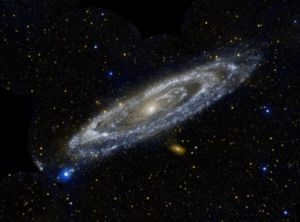
Unfortunately or fortunately, the inhabitants of Earth will not have the opportunity to witness this phenomenon – in 1-5 billion years, the Sun will undergo a process of heating up and expanding, which will likely result in the extinction of life on the planet.
Pest galaxy
In the year 2017, the renowned Hubble telescope captured an image of a distant galaxy that appears to be “camouflaging” itself behind the youthful star HD 107146, a star similar to our own Sun.
This particular galaxy remains nameless, yet it has already presented a challenge to the scientific community. Situated within the constellation known as Veronica’s Hair, astronomers have coined it the “pest” due to its interference with observations of the star HD 107146. What makes this star so intriguing to scientists is its surrounding disk of gas and dust, a breeding ground for the formation of planets, mirroring the early stages of our own solar system.
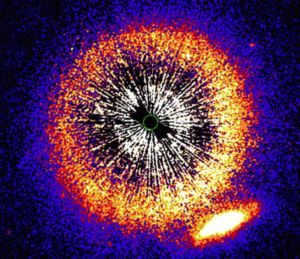
According to the Hubble science team, the presence of the “pest” galaxy’s light has hindered these observations since the discovery of HD 107146 in 2004. However, in recent years, there has been a gradual change in the situation due to the star’s disk movement and its gradual “enclosure” of the distant galaxy.
A celestial body with dual “hearts”
The majority of galaxies possess a supermassive black hole situated at their core. Nevertheless, a subset of these galaxies harbors not just one, but a pair of these immense cosmic entities.
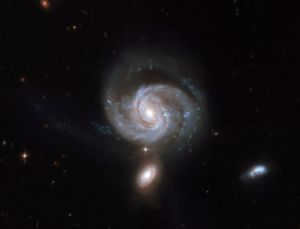
Take NGC 7674 as an example, it is a spiral galaxy that possesses a pair of black holes separated by just one light-year (9,460,730,472,580.8 km) in its center. This galaxy is located 644 million kilometers away from Earth. Scientists speculate that it acquired its second black hole through a collision and merger with another galaxy. The only other known galaxy with two black holes at its core is 0402 + 379 (or 4C +37.11).
Scientists have observed that the majority of galaxies are in fact moving away from Earth as a result of the universe’s expansion. However, there is an exception to this rule – Messier 90. Situated approximately 60 million light-years away, this spiral galaxy is actually moving towards the Milky Way at an impressive speed of 383 km/s. With its vast expanse, Messier 90 is home to an astonishing trillion stars and around 1,000 globular clusters.
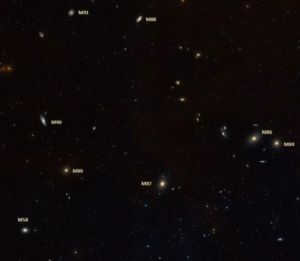
Astronomers were able to observe this movement because the light emitted by Messier 90 has been shifted towards the blue end of the light spectrum. When objects move away from Earth, their light emission is red-shifted, meaning it is shifted towards the red. Messier 90 belongs to a vast collection of galaxies known as the Virgo cluster. According to NASA, it can be observed using a telescope or binoculars from the northern hemisphere in the month of May.
The universe never fails to astound scientists – each year, new and increasingly peculiar galaxies are discovered. It is possible that in the coming year, astronomers will provide evidence for the existence of star clusters that currently appear to be purely fantastical.
For more information, click here
The cosmos is vast, with a multitude of colossal entities within it. Planets, stars, galaxies, and their clusters span distances that are difficult to comprehend. “Hitech” provides insight into the most enormous of these.
Discover “Hitech” here
We are aware that Earth is not the largest planet in the universe; nearby, gas giants Jupiter and Saturn hold that title. However, the Sun is not the most massive star in the cosmos either; it is merely a dwarf in comparison to others. Similarly, our galaxy, the Milky Way, is not particularly large. So, who truly qualifies as space giants?
The most extensive nebula
The Tarantula Nebula holds the title of being the most extensive and dynamic star-forming area in our local galaxy. It covers a vast expanse of 1,800 light-years and is located a staggering distance of 170,000 light-years away from Earth, within the boundaries of the Large Magellanic Cloud.
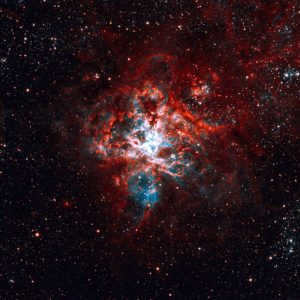
One of the most renowned and active “nurseries” for stars is located here – young stars are born within its exquisite gas and dust folds. A particularly bustling region can be found at the heart of the nebula, within the R136 star cluster.
The most massive galaxy
The largest galaxy ever discovered is IC 1101. Recent observations have revealed its immense size to be approximately 5.6-6 million light-years. In comparison, the Milky Way has a diameter of just 100,000 light-years. If IC 1101 were positioned in place of the Milky Way, its outer reaches would extend all the way to our neighboring Andromeda galaxy.
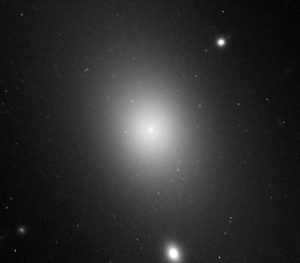
IC 1101 is located in the Virgo constellation, which contains over 100 trillion stars. Its immense size is evident from the fact that it is situated at a distance of 1.04 billion light years from Earth.
The most massive exoplanet
The discovery of GQ Lupi b in 2005 left astronomers astounded. This celestial body revolves around a young star at an astonishingly large distance – approximately 2.5 times the distance between Pluto and the Sun. GQ Lupi b has characteristics that resemble both a planet and a brown dwarf (a type of small star known as a “Hitech”).
Further observations have not provided a definitive answer, but experts now propose that GQ Lupi b has a radius around 3.5 times that of Jupiter. If it is indeed an exoplanet, it would be the largest ever detected.
The Largest Star in the Universe
When discussing the biggest star in the universe, the situation becomes complicated. Most stars have the ability to change their brightness, radius, and effective temperature throughout their lifetimes. Until recently, the prevailing belief was that UY Scuti (also known as UY Shield) held the title of the largest star. This hypergiant star has a radius approximately 1,700 times larger than that of the Sun. To put it into perspective, if UY Shield were placed at the center of our solar system, its edge would extend beyond the orbit of Jupiter. Additionally, the gas and dust surrounding the star would expand even further, surpassing the orbit of Pluto.
However, revised data has revealed that UY Scuti is not the largest star after all. As of 2020, that distinction belongs to Stephenson 2-18.
Located in the constellation Hound Dog, TON 618 is another enormous star. Its immense size is further emphasized by its immense distance from Earth, which measures approximately 10.37 billion light-years.
The most enormous individual entity
During a period when the Universe was a mere fraction of its present age, approximately one-tenth, a remarkable event unfolded as 14 galaxies engaged in active interactions with one another. These galaxies collided and coalesced, giving rise to the colossal and gravitationally bound cosmic object known as the protocluster SPT2349-56, which now holds the title for being the largest single entity ever discovered.
In due course, this protocluster will continue to evolve, ultimately merging into a solitary galaxy boasting a mass that surpasses that of the Sun by a staggering quadrillion times. It is worth noting that the groundbreaking discovery of SPT2349-56 only occurred in 2018.
Bonus: the biggest group of the most brilliant things
Quasars are positioned at the core of active galaxies and represent some of the most brilliant objects recognized within the universe. They emit an amount of energy that is a thousand times greater than that of the Milky Way, which contains anywhere from 200 to 400 billion stars. And during the summer of 2018, scientists from the National Radio Astronomy Observatory in the United States stumbled upon the most radiant quasar of them all. This particular quasar is located 13 billion light-years away from Earth and emerged when the universe was less than 10% of its current size.
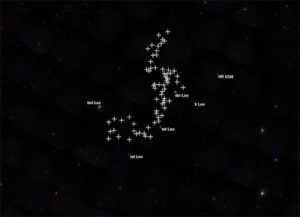
On occasion, quasars can merge to create clusters, like the Huge-LQG (Huge Large Quasar Group). This is an immense cosmic assemblage of 73 quasars with a cumulative mass of 6.1 quintillion (that’s a number with 18 zeros) Suns.
Infinity knows no bounds
Researchers persist in examining the Universe. It’s plausible that the most colossal stars, planets, and galaxies we currently recognize are actually diminutive. At least when compared to the forthcoming discoveries of humanity.
Discover more
Just a little over a century ago, our galaxy was believed to be the largest. In actuality, the others were simply undiscovered, even though astronomers never questioned their existence.
With the progression of technology and the introduction of advanced telescopes, it quickly became evident that the Milky Way paled in comparison to other galaxies in terms of size. Today, we will provide you with information on just how much larger these galaxies are, what they are known as, and where they can be found.
Fascinating fact: If galaxies were to shrink down to the size of apples, neighboring galaxies would be only a few meters away from each other. This close proximity sometimes leads to galaxies merging together.
Now, let’s take a look at the top 10 largest galaxies in the entire Universe.
10. NGC 3842.
NGC 3842, also known as the Black Eye Galaxy, is a fascinating celestial object located in the constellation Leo. With its distinctive dark band stretching across its bright core, it is a truly captivating sight for astronomers and stargazers alike.
NGC 3842 has a diameter of approximately 125,000 light-years, making it one of the largest galaxies in the Leo cluster. It is classified as a lenticular galaxy, which means it has characteristics of both spiral and elliptical galaxies. This unique combination of features makes NGC 3842 an object of great interest for scientists studying galaxy formation and evolution.
The dark band that gives NGC 3842 its nickname, the Black Eye Galaxy, is actually a dust lane that obscures the light from the galaxy’s core. This dust lane is thought to be the result of a recent collision or interaction with another galaxy, which caused the dust and gas to become concentrated in a thin band.
NGC 3842 is also home to a supermassive black hole at its center, which is estimated to have a mass of around 200 million times that of our sun. This black hole is actively accreting matter from its surroundings, emitting powerful jets of radiation in the process. Studying the activity of this black hole can provide valuable insights into the formation and growth of supermassive black holes in the early universe.
Overall, NGC 3842 is a fascinating and visually stunning object in the night sky. Its unique features and scientific significance make it a popular target for both amateur and professional astronomers.
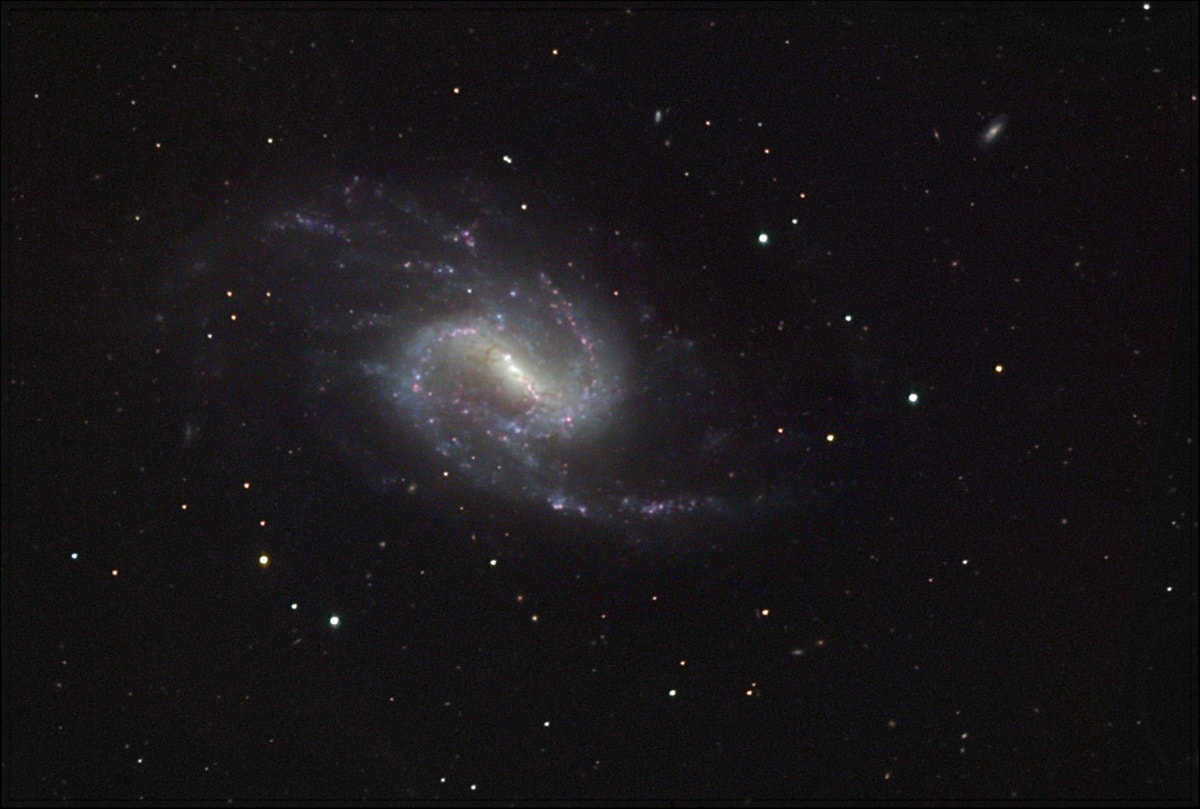
Breaking records is not limited to soccer games and pie-eating contests, but also applies to supermassive black holes.
For instance, in 2010, astronomers made an astonishing discovery in the black hole “weight” competition: they found a colossal black hole in the core of the M87 galaxy that weighs over 6 billion times more than the Sun. However, this record did not last long, as it was surpassed twice in just one year.
One of the current record holders is NGC 3842, a massive elliptical galaxy located in the constellation Coma Berenice. Its mass is nearly 10 billion times the weight of the Sun.
9. NGC 4889 also known as Coma B.
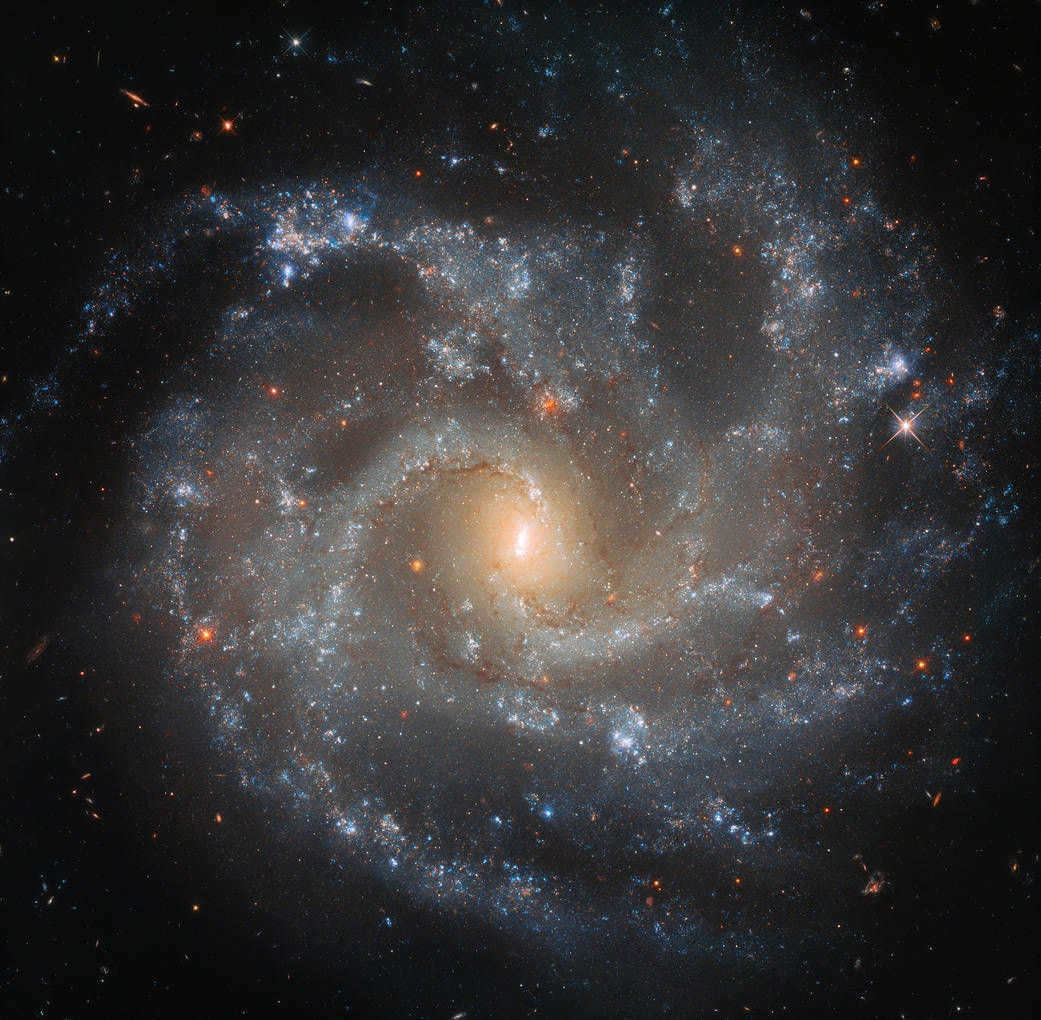
According to astronomers’ estimations (which are becoming less and less inaccurate), the supermassive black hole located in NGC 4889 possesses a weight equivalent to 21 billion times the mass of our Sun. Furthermore, it boasts an event horizon with a diameter measuring approximately 130 billion kilometers. In contrast, the black hole situated at the core of the Milky Way only possesses a mass four times that of the Sun.
Astronomers claim that the black hole, known as NGC 4889, is currently in a state of dormancy. It is taking a break after a prolonged period of devouring stars and dust clouds. While astronomers are unable to directly observe the black hole, they can indirectly determine its mass.
8. NGC 1275 or Perseus A
NGC 1275, also known as Perseus A, is a well-known galaxy located in the Perseus constellation. It is one of the brightest radio sources in the sky and has been extensively studied by astronomers.
NGC 1275 is classified as a Seyfert galaxy, which means it has an active galactic nucleus that is emitting large amounts of energy. The galaxy is also a strong source of X-rays and gamma-rays.
One of the notable features of NGC 1275 is its strong emission lines, which indicate the presence of ionized gas in the galaxy. These emission lines are produced by the interaction between the galaxy’s central black hole and the surrounding gas.
The galaxy is also known for its massive radio lobes, which extend for hundreds of thousands of light-years. These lobes are believed to be caused by powerful jets of particles being ejected from the galactic nucleus.
NGC 1275 is located at a distance of about 237 million light-years from Earth. It is a member of the Perseus Cluster, a large cluster of galaxies located in the constellation Perseus.
In addition to its scientific significance, NGC 1275 is also a popular target for amateur astronomers due to its brightness and distinctive features. Its unique characteristics make it an interesting object for further study and observation.
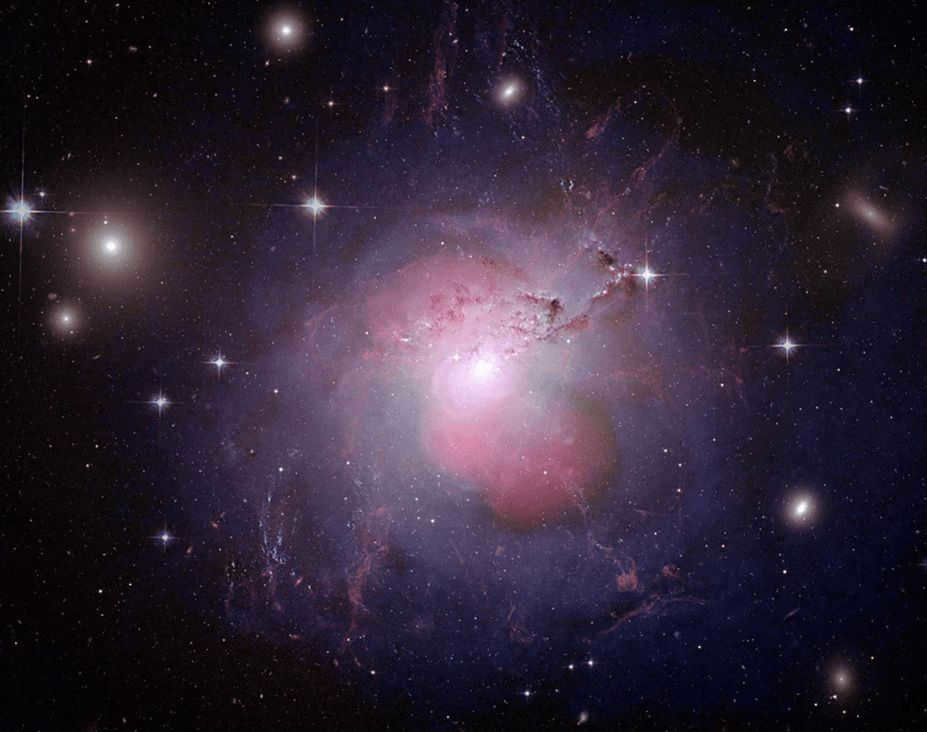
NGC 1275 is an enormous elliptical galaxy situated in the heart of the Perseus galaxy cluster. The pictures reveal the presence of dust streaks originating from a distinct spiral galaxy. This spiral galaxy is partially positioned in front of NGC 1275 and was completely obliterated by the tidal gravitational forces within the Perseus galaxy cluster.
The images display numerous vibrant filaments consisting of newly formed blue stars. By examining the filamentary structure, astronomers were able to calculate the intensity of the magnetic field for the first time. Utilizing this information, they were able to determine how the extragalactic magnetic fields maintained the filament structure, preventing collapse due to gravitational forces or absorption by the surrounding galaxy cluster over their lifespan of 100 million years.
This achievement was made possible through the utilization of images captured by the Advanced Camera for Surveys (ACS) aboard the NASA/ESA Hubble Space Telescope during the months of July and August in the year 2006.
7. The primary galaxy within the Phoenix cluster
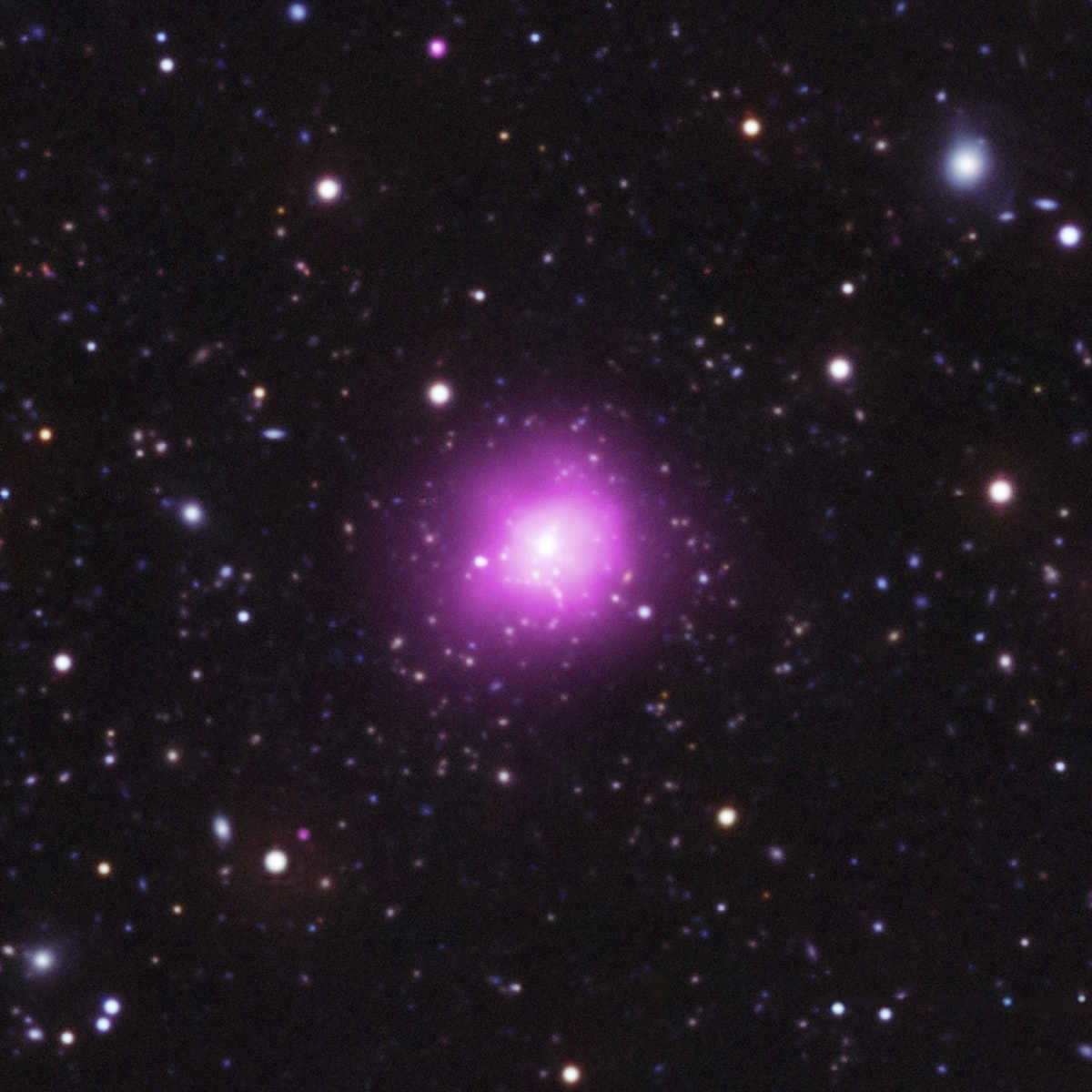
Galaxy clusters are the biggest formations in the universe, held together by the force of gravity and consisting of hundreds or even thousands of galaxies surrounded by hot gas and undetectable dark matter.
The galaxies at the centers of these clusters contain the most massive black holes ever observed. In the instance of the Phoenix cluster, the black hole at its core has a mass equal to that of 5.8 billion suns.
6. NGC 262 also known as Markarian 348

Seyfert type 2 galaxy Markarian 348 (NGC 262) is classified as a typical early-type (SO / a or Sa) disk galaxy that is enveloped by an exceptionally large HI shell. This galaxy measures 1.3 billion light-years in diameter, making it approximately 13 times larger than our own Milky Way.
5. 3C 348 or Hercules A
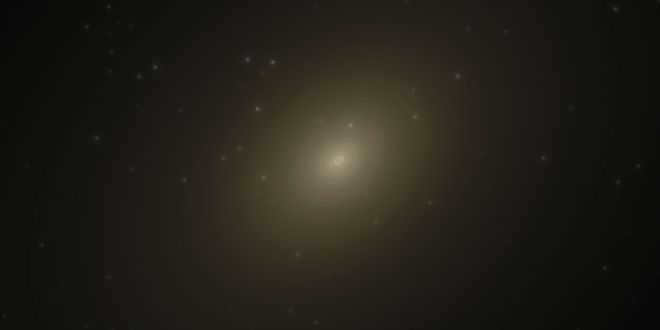
The yellowish elliptical galaxy known as Hercules A appears to be quite ordinary when observed in the visible light spectrum by the Hubble telescope. It is located approximately two billion light-years away.
However, this seemingly unremarkable galaxy actually contains a central black hole that is 2.5 billion times the mass of our Sun. This makes it 1,000 times more massive than the black hole found in our own Milky Way galaxy.
Despite its unassuming appearance, Hercules A, also known as 3C 348, has a reputation for being the brightest radio-emitting object in the constellation Hercules. It emits radio waves that are nearly a billion times larger than those emitted by our Sun, making it one of the most prominent extragalactic radio sources in the entire sky.
4. IC 1101
can be rephrased as
4. IC 1101
is subject to rephrasing.
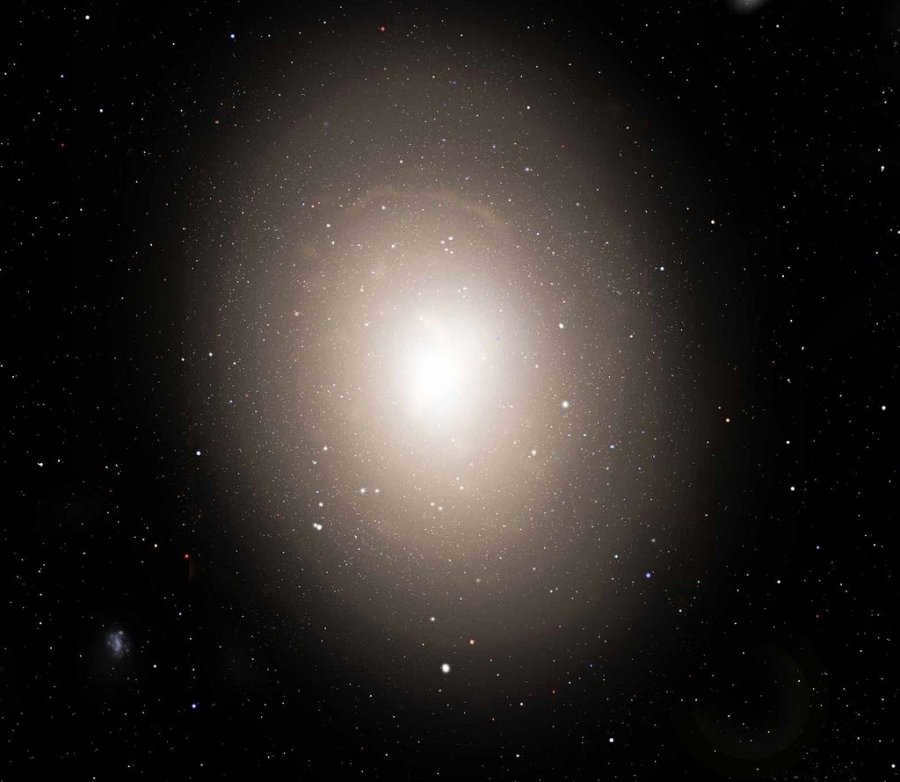
The celestial object known as IC 1101 is located in the distant reaches of space, approximately 1,040,000,000,000 light-years away. It resides within the constellation Virgo, far beyond the naked eye’s ability to perceive. For comparison, the closest visible star to this elliptical galaxy is 3 Serpentis. It is important to note that this nearby star can be seen without the aid of binoculars or a telescope, and its proximity is determined solely on a two-dimensional plane, disregarding actual distance.
While stars visible to the naked eye typically have a magnitude of 6.5, the faintest star that could be observed in this context would have a magnitude of 6.0. In terms of visual brightness, IC 1101 has an apparent magnitude of 14.73, with a measured size of 1.2×0.6. Essentially, this means that IC 1101 cannot be seen by the naked eye from Earth, and one would require a telescope to marvel at its beauty.
3. UGC 9555.
UGC 9555 is the third object in the UGC catalog.
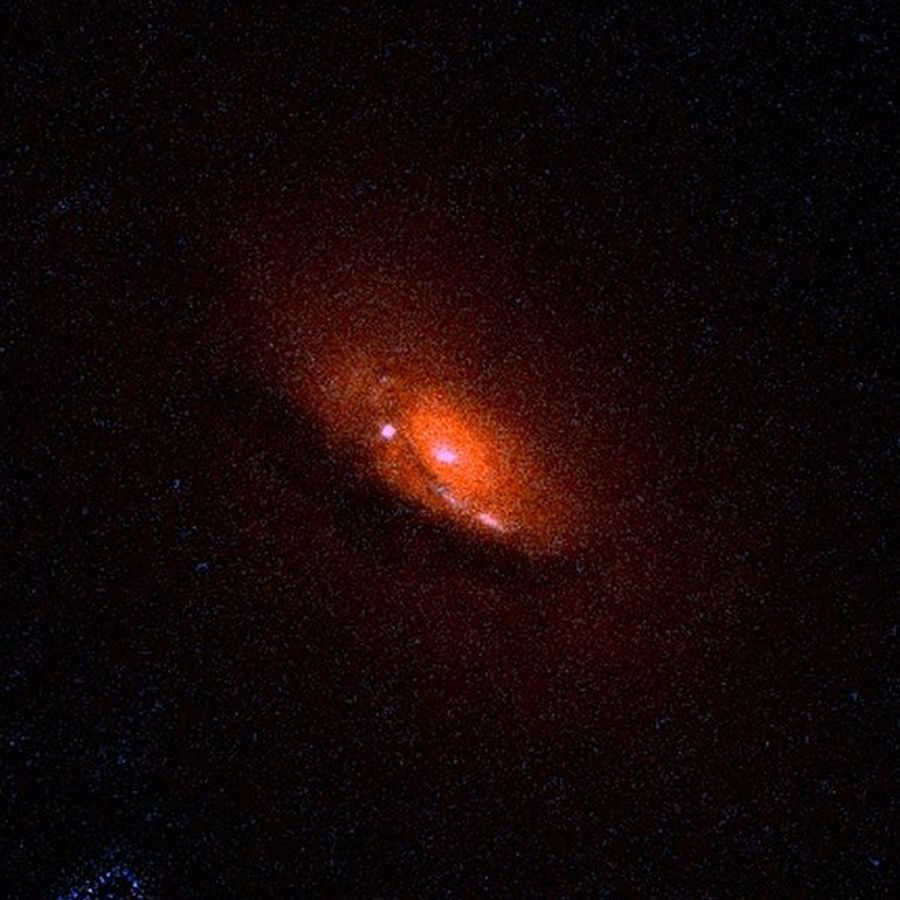
This particular galaxy can be found within a trio of galaxies known as the UGC 9555 system. Situated a staggering 820 million light years away from Earth, this galaxy is surrounded by various components of the larger MSPM 02158 galaxy cluster.
British astronomers have recently made a number of fascinating discoveries while studying this cluster using the Low Frequency Array (LOFAR) instrument. Despite being somewhat outdated both technically and conceptually, this telescope still provides valuable data.
As part of their ongoing project, scientists from the MSSS are closely observing deep space within the frequency range of 119 to 158 MHz. Rather than conducting a blanket analysis across the entire frequency spectrum, they are instead focusing on small 2 MHz increments within specific bands.
Following the recent examination of the radio frequency emission obtained, researchers made an astonishing revelation about the immense proportions of the GRG radio galaxy. In terms of magnitude, it measures approximately the same as a 2.56 Mpc diameter, making it an enormous mass of celestial matter.
2. 3C 236
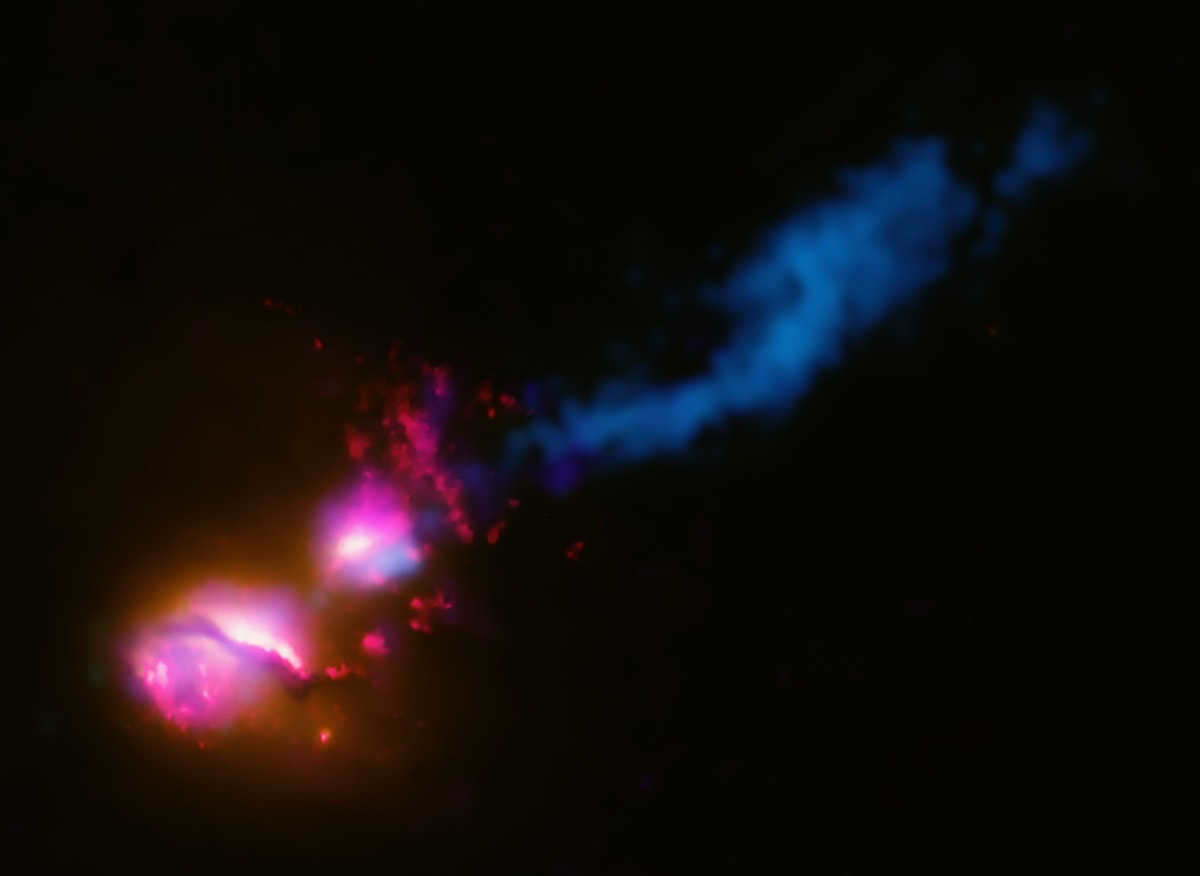
The radio galaxy 3C 236 is a member of the FR II class and it is incredibly massive: its radio structure spans a distance of 15 million light-years. Unlike IC 1101, which would require a spacecraft nearly 4 million light-years to orbit it, 3C 236 would require a distance of 15 million light-years.
